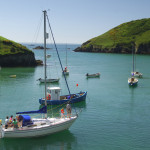Sarah Kingdom offers up her insider guide to magical Muscat, Oman’s characterful capital.
Oman’s characterful capital, Muscat, sits between the Gulf of Oman and the towering Hajar Mountains. Surrounded by the shiny megacities of the Gulf, Oman favours tradition, and in line with the general local belief that no building should be taller than a coconut tree, the country has banned skyscrapers in favour of a low-rise, whitewashed aesthetic with the goal of preserving the city’s culture, natural beauty, and traditional style. You’ll find no glitzy high rises here, instead there’s a sea of low-lying buildings stretching back to the mountains, sporadically interrupted by the domes and minarets of mosques.
Let’s check out my insider guide to magical Muscat’s must-see attractions and activities.
Sultan Qaboos Grand Mosque
Oman’s mosques are a notable exception to the country’s ‘no tall buildings’ policy. A must see in any guide to Muscat, in the heart of Muscat, surrounded by manicured gardens and a network of intricate archways, Sultan Qaboos Grand Mosque and its 91m minaret dominates the city skyline. Quietly imposing from the outside, this fabulous example of modern Islamic architecture opened in 2001, a gift to the nation from Sultan Qaboos, to mark his 30th year of reign.


The main prayer hall is magnificent, with its Persian carpet alone measuring 70m by 60m – it took 600 women four years to weave and until recently was the largest hand-woven carpet in the world. The mosque can accommodate 20,000 worshippers, and with its ornate courtyards, mosaics, prayer halls and beautifully manicured gardens, it’s one of the prettiest sights in the city. Visitors are required to dress modestly, covering arms and legs and avoiding tight clothing. Women and girls (aged seven and above) must cover their hair.
Mutrah Corniche
Take a walk along the Mutrah Corniche, a 2km wide promenade that stretches along the Gulf of Oman on the northern edge of Muscat. This is a great way to get a feel for the city’s waterfront. Along the way pause for a cup of sweet cardamom tea, known as karak chai, marvel at the Masjid Al Rasool Al Adham, the blue-domed Shia mosque that dates back to the 15th century and explore the stalls at the Mutrah Souq. The harbour itself is home to His Majesty, Sultan Haitham bin Tariq Al Said’s dhow, various visiting cruise ships and assorted naval vessels
Mutrah Souq
The Mutrah Souq is one of the oldest markets in Oman, dating back around 200 years. The souq retains the chaotic charm of a traditional Arab market, albeit now housed under a modern timber roof. The legendary covered market begins with a gate at the Mutrah Corniche and ends at another gate in the old quarters of the city. Whether you’re interested in vintage furniture, souvenirs, artisanal silver jewellery, traditional Omani daggers, or spices, incense and perfumes, you’ll find it here – bargaining is expected although discounts tend to be small. Note, it can be easy to get lost here, among the winding pathways and myriad of vendors, so visiting with a local guide is recommended.
Al Alam Royal Palace
If you stand by the harbour wall on Mirani St, the building to your right, with the blue and gold mushroom-shaped pillars, is the Sultan’s Palace. The palace was built over the site of the former British embassy and today is largely used for ceremonial purposes, as the Sultan prefers his quieter, seaside residence near Seeb. Do note that you cannot enter the grounds.
The Royal Opera House

The Opera House is Muscat’s hub of arts and culture, and since opening in 2011 has hosted a variety of top performers from around the world, including ballet, jazz, opera and world music. Known for its exceptional acoustics, the architects’ brief for the 20-acre site, was for a luxurious building with stunning facades and colonnades. The resulting cubic building is a marvel of glistening white marble, soaring archways and stunning arcades. While you can purchase tickets to an opera or a show if you’re in Muscat at the right time, you can also just admire the Opera House from the outside, or take a quick guided tour of the inside
Bait Al Zubair Museum

The privately owned Bait Al Zubair Museum exhibits traditional Omani handicrafts, furniture, stamps, coins, firearms and weapons, including Omani daggers. There are six separate buildings, including a garden with a miniature Omani village, an aflaj (irrigation) system, and a variety of indigenous plants and trees, all showcasing traditional architecture and design and creating a peaceful place for visitors to spend some quiet time.
Game Fishing
The Gulf of Oman is rich in marine life including Marlin, Sailfish, Yellowfin Tuna and Dorado, Trevally, Kingfish, and Barracuda, and with most of Muscat being situated along the shoreline, fishing is a popular pastime for both residents and tourists. Booking a fishing trip in a fully equipped boat and with a professional and experienced skipper, who has a good knowledge of the local waters, is a great way to spend a day and the perfect way to spice up your holiday. Seasoned anglers can show off, while first-timers won’t forget the thrill of catching their first fish. There are trips available for 4 hours, 6 hours and 8 hours. Alsansool comes highly recommended.
Golf
Golf in Oman started in 1970 with just two sand courses. The country now has five grass courses all close to Muscat. Ghala Golf Club is the oldest and most popular golf club in Oman. Established in 1971 by Colonel Cooper, the club started out as a modest 9-hole sand course. It has since grown to 250+ members, more than any other club in Oman, and an 18-hole, fully-grassed course. Situated in the heart of Muscat the course was designed by renowned British golfer, Bill Logmuir, and is set snugly into a wadi, with the dramatic Al Hajar mountains for a stunning backdrop.
Traditional Dhow Sunset Cruise

A good way to watch the sun go down in Muscat is aboard a dhow, a traditional wooden sailing boat. Enjoy the cool sea breeze and listen to the gentle lapping of the water, as you watch the sun sink towards the horizon as the sky changes from blue to orange and pink. This is not only a rather romantic excursion, it’s also a good way to get a glimpse into Oman’s maritime history and see part of the country’s coastline up close. Try Coral Ocean Tours for a 2-hour sunset cruise on Traditional Omani Dhow.
Tempt Your Tastebuds
Historically Oman was an important empire, stretching from the Strait of Hormuz, to parts of India, and all the way to Zanzibar. Trade has been a part of Omani culture for centuries, and Omani food has been directly influenced by this, with the resulting cuisine containing a blend of spices and flavours.

There’s not much street food in Oman. But what you will find is mishkak, skewers of marinated grilled meat and seafood. Marinated in garlic, ginger, and spices, then grilled over flaming hot charcoal, mishkak is eaten either with spicy chilli sauce or tamarind sauce. At various points along the beach area, several permanent street food stalls sell mishkak. You can either eat in the air-conditioned comfort of your car or take a seat at one of the plastic tables and chairs in the car park while you devour the smoky skewers.
Halwa is a very sweet, sticky Omani dessert, made from starch and sugar cooked into a thick sticky paste and seasoned with rosewater, saffron, and nuts. This is one of the only authentic Omani desserts and if you have a sweet tooth you’ll love it. One of the best places in Muscat for halwa is Al Diwaniya.

Another significant part of Omani culture is tea and coffee. Omani coffee, kahwa, is typically quite weak, with hints of rosewater and saffron. It’s a popular social drink because as it’s not strong you can drink numerous cups in a row. Tea on the other hand, called karak, is usually strong, sweet, and spiced with cardamom, clove, cinnamon and ginger. Sweetened condensed milk gives it its intense creaminess.
Tell me more about this Insider Guide to magical Muscat.
How To See Muscat
A great way to experience this inside guide to Muscat is with a local guide. Bubbly, friendly and knowledgeable, Hajer Al Muzayni is a guide with tour company With Locals. She’s got her finger on the local pulse and showed us hidden gems and quirky corners of Muscat that most tourists might miss. Sign up for a 5-hour Full Coverage Muscat City Tour and ask for her by name!
Where To Stay
The five-star The Chedi Muscat, sits in meticulously manicured grounds, on a lovely stretch of Muscat coastline. Centrally located, near most of the city’s top attractions, the Chedi is a luxurious escape, elegant without being ostentatious. A pretty beach, tranquil grounds, lovely rooms and villas, fantastic restaurants and not one but three swimming pools, it’s no wonder the Chedi is one of the most sought after hotels in Muscat.






